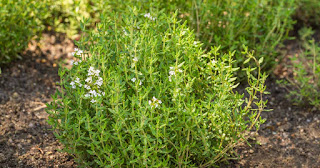Thyme Plant Information.
Thyme Plant Information.
I. Botanical Overview
Thyme, scientifically known as Thymus vulgaris, is a low-growing perennial herb that belongs to the Lamiaceae family. This herb is native to the Mediterranean region but is now cultivated and grown worldwide. Here are some key botanical characteristics of the thyme plant:
1. Growth Habit: Thyme is a woody
-stemmed plant that typically grows to a height of 6 to 12 inches (15 to 30 cm). It forms dense, spreading bushes with numerous branches.
2. Leaves: The leaves of thyme are small, oval
-shaped, and packed with aromatic oils. They are typically green or gray-green in color, depending on the variety.
3. Flowers: Thyme produces tiny, tubular flowers that vary in color from white to purple, depending on the cultivar. These flowers are not only attractive but also attract pollinators.
II. Culinary Uses
Thyme is renowned for its culinary versatility and is a staple in many cuisines around the world. Its earthy, slightly minty flavor pairs well with a wide range of dishes. Here are some popular culinary uses of thyme:
1. Seasoning: Thyme is a common ingredient in various spice blends, such as Herbes de Provence and Italian seasoning. It adds depth and aroma to soups, stews, and roasted meats.
2. Fresh and Dried: Thyme can be used fresh or dried. Fresh thyme leaves are often added to dishes during cooking, while dried thyme is an excellent addition to spice rubs and marinades.
3. Infusions: Thyme can be infused into oils, vinegars, and even cocktails, imparting its delightful flavor to these liquids.
III. Medicinal Properties
Beyond its culinary applications, thyme has a long history of use in traditional medicine. It contains various bioactive compounds that contribute to its health benefits. Some of its medicinal properties include:
1. Antioxidant Properties: Thyme is rich in antioxidants like flavonoids, which help combat oxidative stress and reduce the risk of chronic diseases.
2. Antibacterial and Antifungal: Thyme contains thymol, a potent compound with antimicrobial properties. It has been used to treat respiratory infections and as a natural disinfectant.
3. Respiratory Health: Thyme has been used to alleviate respiratory issues like coughs and congestion. It is often found in herbal cough syrups and teas.
IV. Growing Thyme
If you're interested in cultivating thyme in your garden, here are some tips to get you started:
1. Soil and Sun: Thyme prefers well-draining soil and full sunlight. It thrives in slightly alkaline soil conditions.
2. Propagation: Thyme can be grown from seeds, cuttings, or by dividing established plants.
3. Maintenance: Prune thyme regularly to encourage bushy growth and prevent it from becoming leggy.
Conclusion
Thyme is a remarkable herb with a rich history, delightful flavor, and numerous health benefits. Whether you're using it to enhance the taste of your dishes or for its medicinal properties, thyme is a versatile and valuable addition to any garden or kitchen. Explore the world of thyme and discover the many ways it can elevate your culinary and wellness experiences.



0 Comments